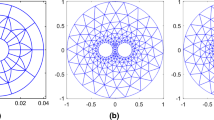Abstract
Numerical studies of multiple voids growth are carried out on a nonlinear hyper-elastic 2D cylinder subjected to an expansionary boundary condition. For certain compressible hyper-elastic material, our numerical experiments on the case of two voids revealed that both the positions and initial sizes of the pre-existing voids can have significant effects on the final grown configuration. We found that, for the initial voids of macroscopic scale both factors affect the final result in a continuous manner and two grown voids of comparable size are commonly observed, and for the initial voids of mesoscopic scale the size effect is no longer continuous and one of the grown voids is always found significantly greater than the other, while for the initial voids of microscopic scale the position effect is essentially decisive on the voids growth and the center positioned void always grows much more rapidly. We also found that the size and position effects are stronger if the material is less compressible, or the load, with the smaller principle stress in alignment with the two voids, is less symmetric.
Similar content being viewed by others
References
Ball JM (1982) Discontinuous equilibrium solutions and cavitation in nonlinear elasticity. Philos Trans R Soc Lond Ser A Math Phys Sci 306: 557–611
Gent AN, Lindley PB (1958) International rupture of bonded rubber cylinders in tensions. Proc R Soc Ser A 249: 195–205
Gurson AL (1977) Continuum theory of ductile rupture by void nucleation and growth: part I—yield criteria and flow rules for porous ductile media. J Eng Mater Technol 99(1): 2–15
Lian Y, Li Z (2011a) Dual-parametric finite element method for cavitation in nonlinear elasticity. J Comput Appl Math 236(5): 834–842
Lian Y, Li Z (2011b) A numerical study on cavitations in nonlinear elasticity—defects and configurational forces. Math Models Methods Appl Sci 21(12): 2551–2574
Lopez-Pamies O (2009) Onset of cavitation in compressible, isotropic, hyperelastic solids. J Elast 94: 115–145
Lopez-Pamies O, Nakamura T, Idiart MI (2011a) Cavitation in elastomeric solids: I—a defect-growth theory. J Mech Phys Solids 59: 1464–1487
Lopez-Pamies O, Nakamura T, Idiart MI (2011b) Cavitation in elastomeric solids: II—onset-of-cavitation surfaces for neo-hookean materials. J Mech Phys Solids 59: 1488–1505
McClintock FA (1968) A criterion for ductile fracture by growth of holes. J Appl Mech 41: 964–970
Michel JC, Lopez-Pamies O, Ponte Castañeda P, Triantafyllidis N (2007) Microscopic and macroscopic instabilities in finitely strained porous elastomers. J Mech Phys Solids 55: 900–938
Needleman A (1972) Void growth in an elastic-plastic medium. J Appl Mech 39(4): 964–970
Rice JR, Tracey DM (1969) On the ductile enlargement of voids in triaxial stress fields. J Mech Phys Solids 17: 201–217
Sivaloganathan J, Spector SJ (2002) On cavitation, configurational forces and implications for fracture in a nonlinearly elastic material. J Elast 67: 25–49
Tvergaard V (1981) Influence of voids on shear band instabilities under plane strain conditions. Int J Fract 17: 389–407
Tvergaard V (1982a) Ductile fracture by cavity nucleation between larger voids. J Mech Phys Solids 30: 265–286
Tvergaard V (1982b) On localization in ductile materials containing spherical voids. Int J Fract 18: 237–252
Tvergaard V (1996) Effect of void size difference on growth and cavitation instabilities. J Mech Phys Solids 44(8): 1237–1253
Xu X, Henao D (2011) An efficient numerical method for cavitation in nonlinear elasticity. Math Models Methods Appl Sci 21(8): 1733–1760
Author information
Authors and Affiliations
Corresponding author
Rights and permissions
About this article
Cite this article
Lian, Y., Li, Z. Position and size effects on voids growth in nonlinear elasticity. Int J Fract 173, 147–161 (2012). https://doi.org/10.1007/s10704-011-9674-y
Received:
Accepted:
Published:
Issue Date:
DOI: https://doi.org/10.1007/s10704-011-9674-y




